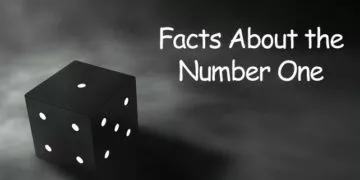Over the ages, people have attributed many facts to numbers.
Numerology, superstition, important dates and so many other things cling to various numbers, which in some cases gives them great significance!
Today let’s take a look at 10 fun facts about the number 3
In the game of baseball, a batter is out of the match if he strikes out three times. This incident is called a strikeout, with a strike meaning that the batter was unable to hit the ball when it was pitched correctly.
The number three is considered a lucky number in Chinese culture. The reason it’s considered to be so is because the word for three sounds very similar to the word for alive. This is quite contrary to western traditions which have such sayings as “third times a charm”, which puts forth the idea that the number three is actually lucky.
Within Norse mythology, it is said that there will be a string of three incredibly harsh winters back-to-back in the lead up to Ragnarok. Ragnarok is said to be a period when a great fight happens that changes the shape of the world forever, in which the main Norse gods all perish and the world is created anew.
The term “hat-trick” is used in many different sports, with each meaning having a connection to the number three. In cricket, for example, a bowler has achieved a hat-trick if they bowl (removes from play) three batters in three consecutive throws. In both soccer and hockey, a hat-trick is when a player scores three goals.
The atomic number of the chemical element lithium is three. In normal conditions, lithium takes on a silvery-white appearance. This alkali metal is the lightest of all metals and is extremely flammable. One of the most common places you will find lithium is within lithium batteries.
Most colors that humans can see can be made from a combination of just three colors. In this case, these colors are called primary colors. Different primary colors are used for different purposes. When you’re mixing paint you can achieve almost any color by mixing the pigments of blue, yellow, and red. On the other hand, all the colors in your TV are made up of a combination of red, green, and blue.
Anything that is referred to as three-dimensional is something that takes up space in three different dimensions. For example, a square you draw on a piece of paper has two dimensions – length and breadth (width). An apple that you can hold in your hand is three dimensional, as it has length, breadth (width), and height!
It’s considered unlucky to light three cigarettes with the same match. The origins of this superstition vary quite a lot, but the most common possible source comes from World War I. As the story goes, if a sniper spots a soldier in the trenches and lights a cigarette he will be alerted. By the time the second cigarette is lit, he has aimed his sniper rifle. The third man to light his cigarette would be shot, as the sniper has had enough time to prepare. Whether there’s truth to this or not, the superstition has stuck.
A different way to write the number three was produced to prevent confusion and potential forgery. This variation of the number has a flat top, and was created so that the number couldn’t be easily changed into the number eight.
It’s commonly believed that within early civilization when humans were first learning to count, we had a word for one, a word for two, but instead of a word for three we had a word for “many”. Much of the evidence which supports this theory comes from such counting practices used within tribes in the Amazon jungle.
It’s easy to see with a number like three why it’s so prevalent in our everyday lives, our histories, our superstitions, and our culture.
After all, it’s the third number, and third time is a charm, right? It’s quite a confusing number, really – some say it’s unlucky, some say it’s lucky.
Coming third isn’t as good as coming first or second, but scoring three points in many sports is a hat-trick.
I like to see the positives of the number instead of the possible negatives, what about you?


















